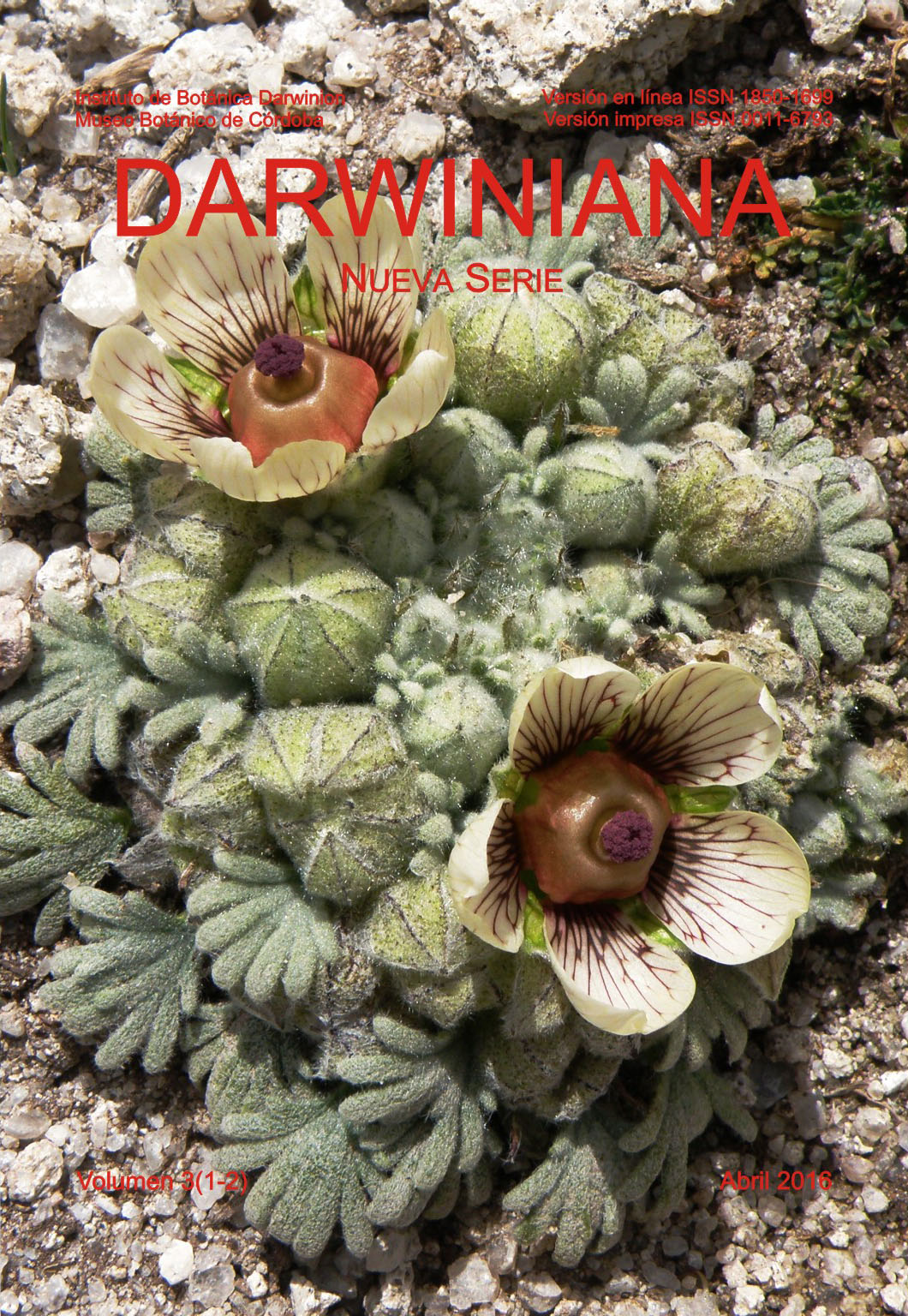Lythrum salicaria (Lythraceae), new record for the Argentinean flora
DOI:
https://doi.org/10.14522/darwiniana.2015.31.668Keywords:
Argentinean Flora, Lythraceae, LythrumAbstract
Lythrum is a cosmopolitan genus with about 36 species of annual and perennial herbs. Lythrum salicaria, one of the most widely distributed species of this genus, grows at riverine sites in several countries, and is highly invasive outside its natural range. In this paper we report for the first time the presence of a spontaneous population of L. salicaria in Argentina. Specimens we collected at Las Golondrinas, Chubut province, from which a morphological description was made. An identification key for all three Lythrum species that inhabit in Argentina is presented.References
Ågren, J. 1996. Population size, pollinator limitation, and seed set in the self-incompatible herb Lythrum salicaria. Ecology 77: 1779-1790. DOI: http://dx.doi.org/10.2307/2265783
Dimitri, M. J. 1979. Lythrum, en L. R. Parodi (ed.), Enciclopedia Argentina de Agricultura y Jardinería, 3ra ed., actualizada por M. J. Dimitri, vol. 2, pp. 814. Buenos Aires: ACME.
Edwards, K. R. 2012. Lythrum salicaria L. (purple loosestrife), en R. A. Francis (ed.), A handbook of Global Freshwater Invasive Species, pp. 91-102. London: Earthscan.
Farnsworth, E. J. & D. R. Ellis. 2001. Is purple loosestrife (Lythrum salicaria) an invasive threat to freshwater wetlands? Conflicting evidence from several ecological metrics. Wetlands 21: 199-209. DOI: http://dx.doi.org/10.1672/0277-5212(2001)021[0199:IPLLSA]2.0.CO;2
Flanagan, R. J.; R. J. Mitchell & J. F. Karron. 2010. Increased relative abundance of an invasive competitor for pollination, Lythrum salicaria, reduces seed number in Mimulus ringens. Oecologia 164: 445-454. DOI: http://dx.doi.org/10.1007/s00442-010-1693-2
Gaudet, C. L. & P. A. Keddy. 1995. Competitive performance and species distribution in shoreline plant communities: a comparative approach. Ecology 76: 280-291. DOI: http://dx.doi.org/10.2307/1940649
Graham, S. A. 2008. Lythraceae, en F. O. Zuloaga, O. Morrone & M. J. Belgrano (eds.), Catálogo de las Plantas Vasculares del Cono Sur (Argentina, sur de Brasil, Chile, Paraguay y Uruguay). Monographs in Systematic Botany from the Missouri Botanical Garden 107: 2433-2441.
Keddy, P. A.; L. Twolan-Strutt & I. C. Wisheu. 1994. Competitive effect and response rankings in 20 wetland plants: are they consistent across three environments? Journal of Ecology 82: 635-643. DOI: http://dx.doi.org/10.2307/2261270
Lourteig, A. 1943. Lythraceae argentinae. Lilloa 9: 317-421.
Lourteig, A. 1988. Lythraceae, en M. N. Correa (dir.), Flora Patagónica. Colección Científica del Instituto Nacional de Tecnología Agropecuaria 8(5): 249-252.
Mabberley, D. J. 2008. Mabberley’s Plant-Book: a portable dictionary of plants, their classification and uses, 3rd ed., pp. 508 New York: Cambridge University Press.
Nagel, J. M. & K. L. Griffin. 2001. Construction cost and invasive potential: comparing Lythrum salicaria (Lythraceae) with co-occurring native species along pond banks. American Journal of Botany 88: 2252-2258. DOI: http://dx.doi.org/10.2307/3558387
Pyšek, P.; D. M. Richardson; M. Rejmánek; G. L. Webster; M. Williamson & J. Kirschner. 2004. Alien plants in checklists and floras: towards better communication between taxonomists and ecologists. Taxon 53: 131-143. DOI: http://dx.doi.org/10.2307/4135498
Sykes, W. R. 1988. Lythraceae, en C. J. Webb, W. R. Sykes & P. J. Garnock-Jones (eds.) Flora of New Zealand, vol. 4, Naturalised Pteridophytes, Gymnosperms, Dicotyledons, pp. 816-820. Christchurch: Botany Division, Department of Scientific and Industrial Research.
Thiers, B. [permanentemente actualizado, consulta 2015] Index Herbariorum: a global directory of public herbaria and associated staff. New York Botanical Garden’s Virtual Herbarium, http://sweetgum.nybg.org/ih
Velayos Rodríguez, M. 1997. Lythrum, en S. Castroviejo, C. Aedo, M. Laínz, F. Muñoz Garmendia, G. Nieto Feliner, J. Paiva & C. Benedí (eds.), Flora Ibérica 8, pp. 15-25. Madrid: Real Jardín Botánico, CSIC.
Waites, A. R. & J. Ågren. 2004. Pollinator visitation, stigmatic pollen loads and among-population variation in seed set in Lythrum salicaria. Journal of ecology 92: 512-526. DOI: http://dx.doi.org/10.1111/j.0022-0477.2004.00893.x
Weihe, P. E. & R. K. Neely. 1997. The effects of shading on competition between purple loosestrife and broad-leaved cattail. Aquatic Botany 59: 127-138. DOI: http://dx.doi.org/10.1016/S0304-3770(97)00023-5
Wiersema, J. H. & B. León. 2013. World Economic Plants. A standard reference, 2nd ed., pp. 422. London: CRC Press.
Additional Files
Published
How to Cite
Issue
Section
License

Starting on 2012, Darwiniana Nueva Serie uses Licencia Creative Commons Atribución-NoComercial 2.5 Argentina .






